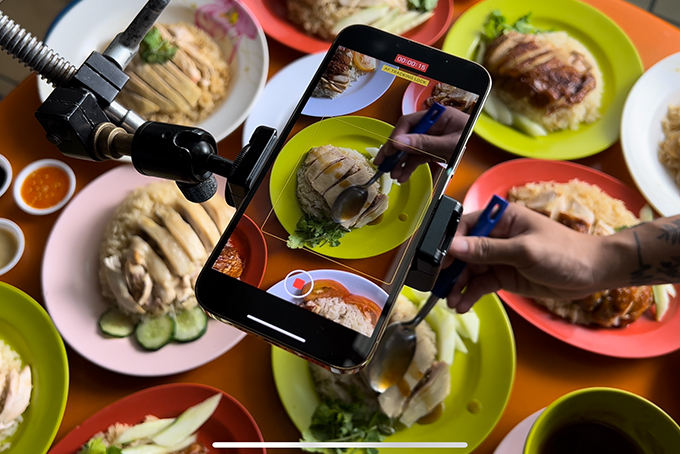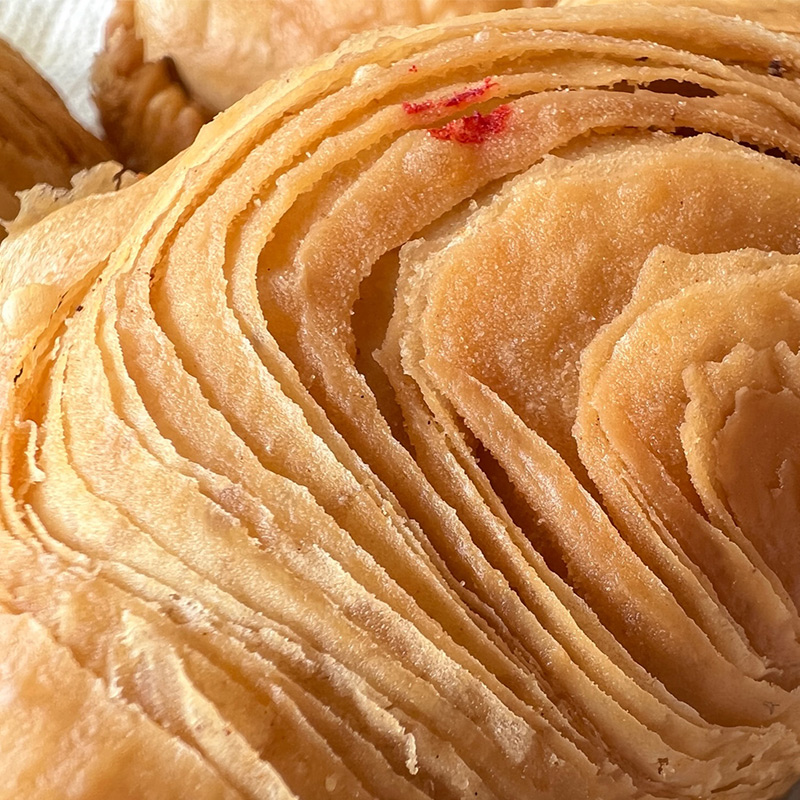Like many of us, David Gelb has a real affinity for food. But unlike most, the esteemed director and documentarian happens to also have the skills required to beautifully capture his passion on camera. Gelb is known best for his culinary-centric projects—whether it’s Jiro Dreams of Sushi, his first-ever documentary based on the iconic sushi master behind Michelin three-starred restaurant Sukiyabashi Jiro, or the Emmy-winning Netflix series Chef’s Table, created and directed by Gelb.
Now, Gelb is bringing his unique talent for immortalising stories about food to Singapore, with a nostalgic short film centered on our hawker culture. In particular, Gelb zones in on the one dish that speaks to anyone with a relationship to the island—a glistening plate of chicken rice. Shot entirely on the iPhone 13 Pro, the film delves into the past and present of family-run hawker stall Tian Tian Hainanese Chicken Rice, resulting in a light-hearted celebration of the multi-generational business and our uniquely-Singaporean culinary obsession.
The film is launching as part of Apple’s larger campaign designed to memorialise hawker culture. To that end, we also round up tips and tricks from top Singaporean food content creators on how best to capture the food we love through the expert-approved lens of an iPhone 13 Pro camera. Here, find the best of those pointers, alongside an exclusive interview with Gelb on his relationship with chicken rice, his own food photography tips and why the iPhone 13 is a small but mighty tool for filmmaking.
Q&A with David Gelb
‘Poached’ centers around one of Singapore’s most beloved dishes—chicken rice. Tell us how you felt when you first had it and what you loved about it.
One of the first things that struck me was the temperature. The rice is nice and warm, and the chicken is at a room temperature. It’s super flavourful, tender, and it has that incredible sauce. I tried it first by itself, before I added any other sauce, because I also liked the dark sauce and chilli. I was struck by just how delicate and delicious the chicken is—and this poaching process is really what makes the chicken the way it is. I really loved it.
How did you find filming in Singapore? How did you cope with the heat, especially in the hawker centres?
I’ve been to Singapore before and I love it. I love going to a hawker centre and not even knowing what I’m going to eat—and looking around to see where the queues are, because you know that’s where the most delicious thing is. Eating in Singapore is one of my favourite things to do because it’s such a great destination for food—apart from the hawker food, there’s also such incredible fine dining.
Shooting in Singapore is different from shooting Chef’s Table, where you’re in an air-conditioned, three-Michelin starred restaurant. There’s a lot of energy both in the heat and activity of the hawkers. Not only do you have the heat from the humidity, you have their stoves going. It’s an intense environment but it was very exciting and fun.
How long were you in Singapore for?
We were there for a week and a half—preparing, scouting, fostering relationships with the hawkers, figuring out exactly what we were shooting. One of the cool things about shooting on iPhone is that even when I’m scouting and looking around, I’m able to take shots that are of quality that we can put into the film. There is so much to do, and so many different delicious dishes to make—it was very difficult choosing what would make it to the final film.
Tell us more about your experience shooting on the iPhone 13 Pro.
It’s a great tool that I wish I had when I was making Jiro Dreams of Sushi and some of my earlier work. You can shoot in slow motion, you can shoot in cinematic mode where you can choose where you want the focus to be like you would with a large camera lens. We have low-light shooting—so I don’t need as much lighting, sometimes no lighting at all to be able to get a nice and bright image. With macro mode, you can shoot super close-up. To have all these different features in a compact device is brilliant—one of the challenges of shooting in a hawker centre is there’s no wasted space, every inch of the kitchen has something going on. There’s no room for a camera person, so in many situations, we mount the camera with a suction cup. It might also be a difficult-to-see kind of area, because sometimes we have to place the camera around a corner and you don’t know what you’re shooting. In this case, you use your Apple Watch as a periscope to see what’s going on, and that’s a fun kind of puzzle to solve, and that’s the perfect tool to help solve that puzzle.
“Even if you can’t go to a film school, if you can get your hands on an iPhone, you can make a movie”
Has using the iPhone to shoot altered the way you edit your videos?
In this case, I would say not at all. I’ve done many seasons of Chef’s Table and Street Food, and Wolfgang on Disney+. I’ve done these types of films about passionate chefs many times, so I have a system that really works. Part of the challenge we posed to ourselves was, ‘Can I put the iPhone through that?’ It really works just fine. What we really want is for the tool to fade away, and you’re just really thinking about the story. When it came to editing, we forgot we were shooting on an iPhone—it was a matter of telling a great story, and choosing the best visuals.
How beneficial is the iPhone 13 Pro to young filmmakers today?
I wish I had the iPhone when I was first starting out. There are things you can do with the time lapsing and slow motion, and I used to have to borrow a camera from my film school to be able to do it. Even then, you would have to shoot on film, you would need more crew, you would need to develop the film and everything. Eventually, slow motion became available on digital cameras, but these cameras are much more expensive than the iPhone. I think that film students can really benefit from it. Even if you can’t go to a film school, if you can get your hands on an iPhone, you can make a movie.

What would you love to capture if you were to do another film on a particular aspect of Singapore?
Singapore has an interesting history, the architecture is fascinating, the combination of old and new. I love the shophouses. But I’m always drawn in by a great story and great characters. I would want to find somebody that has a great story, some kind of drama, and that’s what makes a good film. The beauty of the images is just something that is just an expression of the characters.
What are your top tips when it comes to taking photos on the iPhone?
Finding a place with nice light—find the shade and look at the environment around you. Ultimately, it is also about finding something memorable to shoot. What is the thing you’re filming? What are you taking a picture of? Is it family, friends or a beautiful plate?
What can we find on your camera roll? Is it mostly of food?
I don’t shoot food as much for personal reasons, because I find myself thinking if I’m working or overthinking it. Am I micromanaging it and do I move a crumb or grain of rice to make it perfect? I leave that in the office. When I go out and eat, I try to just enjoy it. I’m more likely to take pictures of friends and family—or if my son is eating something he thinks it’s yummy, then yes, that food makes it into the roll.
The best tips for food photography on your iPhone 13 Pro

Don’t be afraid to get up close
“Use macro on the iPhone and think about how framing can change when you’re looking at something close-up. Suddenly, the flaky folds of a curry puff look almost like a sand dune, or even otherworldly. You can play with textures and highlight them differently this way,” says chef and food content creator Sarah Huang Benjamin.
Make full use of the Slo-mo function
“Slo-mo is a great feature to highlight and draw attention to specific actions, such as the flipping of prata, which may sometimes be too fast to capture,” says food photographer Melissa Patrice.
Play around with Photographic Styles
“Warm undertone generally makes our local dishes look yummier, so I pick a warm Photographic Style,” says photographer Audrey Kwok.
Find the right backdrop
“Using a solid-coloured t-shirt as a backdrop is an excellent way to allow the bright colours and textures of your food to pop against your torso,” says food stylist and photographer C.R Tan.





